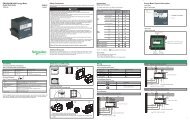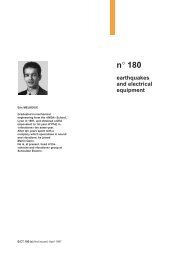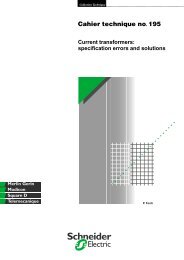Low Voltage circuit-breaker breaking techniques - Schneider Electric
Low Voltage circuit-breaker breaking techniques - Schneider Electric
Low Voltage circuit-breaker breaking techniques - Schneider Electric
- No tags were found...
You also want an ePaper? Increase the reach of your titles
YUMPU automatically turns print PDFs into web optimized ePapers that Google loves.
2 The electric arcThe electric arc is no invention, but appeared tothe first physicist who tried to break a <strong>circuit</strong>through which a current flowed.Circuits, always inductive, supply electrons withsufficient energy to cross the distance in theconductor separation zone.The gas present, normally air, is ionised bythese "pioneer" electrons and the resultingplasma will then facilitate current flow.Breaking thus seems somewhat compromised....unless a better understanding of thisphenomenon were to reveal remarkable andeven irreplaceable properties.Luckily this is the case !2.1 Its formation conditionsThe arc appears in gaseous atmospheres:c by dielectric breakdown between twoelectrodes:v beyond an electric field value E/d, dependenton electrode shape and on gas type and density(d = distance between electrodes ( see fig. 2 );v further to moving over insulating materials inthe ambient gas.c as soon as an electric <strong>circuit</strong> opens throughwhich current flows, even if the <strong>circuit</strong> is purelyresistive, a certain opening distance is necessaryto prevent dielectric breakdown.EFig. 2 : electric arc and influence of field E/d value.Moreover, any attempt to reduce current rapidlycreates a high L di/dt thus favouring breakdownat any current level.d2.2 Its physical properties (see fig. 3a)As soon as two contacts separate, one of them(cathode) transmits electrons and the other one(anode) receives them. Since electronicemission is by its very nature energy generating,the cathode will be hot. With the arc foot thusbecoming thermoemissive, the electrons aremostly emitted at the hot spot, resulting in arcstagnation which can give rise to metallicvapours. These vapours and the ambient gaswill then be ionised, hence:c more free electrons ;c the creation of positive ions which drop backon the cathode, thus maintaining its hightemperature;c the creation of negative ions which bombardthe anode causing temperature to rise.All this occurs in a high temperature plasmacolumn, from 4 000 to 20 000 K according tocolumn current and confinement.2.3 Its electrical properties (see fig. 3b)c its most striking property is the appearance ofan arcing voltage, which has:v a fixed part, U AC ≈ 20 to 40 V which appearson the slightest separation of the contacts(depending on the materials used),v a variable part, U L = 50 to 100 V/cm, when thearc is stabilized in elongation in pressuretemperaturebalanced conditions.i.e. a total value U a = U AC+ U L.Note that:- the sign of Ua changes at the same time as thearcing current sign,- the arcing current value does not have any realeffect on arcing voltage. This is because the arc"works" with a virtually constant current density(j=i/s), (the anode and cathode spot cross-Cahier Technique <strong>Schneider</strong> <strong>Electric</strong> no. 154 / p.6
















